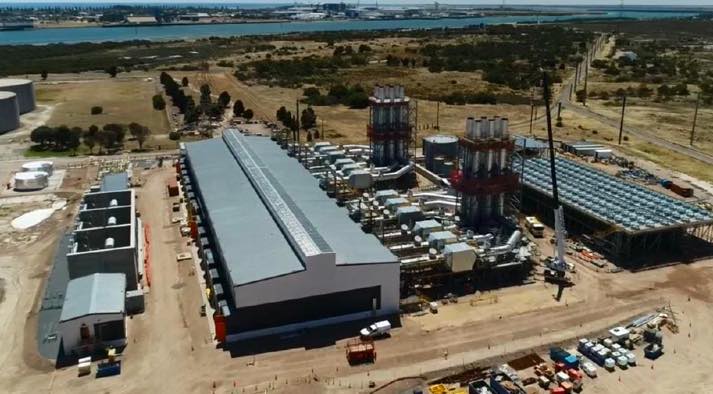From Renew Economy
Plus another wind farm proposal in the Barossa Valley has had its planning permission withdrawn.Big wind farm and even bigger battery approved for South Australia
RES Australia plans to build a 183MW wind farm with a 215MW big battery near South Australia’s Barossa Valley have won development approval from the state government, the company said on Friday.
The approval comes some five months after the South Australia’s State Commission Assessment Panel resolved to grant development plan consent to the Twin Creek Wind Farm, subject to planning conditions, reserved matters and advisory notes.
The wind farm’s battery system stands to be one of the biggest in Australia and will more than match the capacity of the wind farm, which will host 51 turbines across various parcels of crop and sheep grazing land, spread across three council areas around 90km north of Adelaide.
The final specifications of the battery – and the amount of actual storage – will be decided based on the economics, storage need and likely what other rival storage projects are up to.
For RES Australia, the permitting of Twin Creek takes the company past 2GW of new renewable energy capacity approved for development, adding to recent approvals for the 176MW Pallamana solar farm in South Australia in July, and the 200MW Avonlie solar project in New South Wales.
Projects queue to take South Australia to 100 per cent renewables
Twin Creek is one of a number of huge renewable and storage projects proposed for South Australia, many of them waiting for an opportunity presented by a new transmission link to NSW, and the state Liberal government’s commitment to reach “net 100 per cent renewables” in South Australia in the next decade.
Twin Creek has not had an easy time winning over locals, however, with numerous concerns registered over its visual impact, impact on flora and fauna – and even on human health.
This opposition culminated in a locally sponsored legal bid to have the wind farm reclassified as a Category 3 development, which would have cleared the way to appeal its planning approval. That case was rejected by the state’s Environment Resources and Development Court in March.
In a statement, RES says it has fine-tuned the layout of the site through discussions with the local community, maintaining a 2km buffer from the nearest non-associated dwellings and limiting the number of turbines in biodiversity offset areas to preserve and protect wildlife.
“We are proud to say that we have taken every possible action to mitigate the impact of this development on the local wildlife and community,” says RES’s Twin Creek project manager Dan Leahy.
“Our aim is for Twin Creek to support the area’s biodiversity as well as its people, and the project will bring 160 construction jobs, followed by ongoing employment for 8 people. The local towns have seen a number of businesses close in recent years, and this project will provide a tremendous economic boost to the area.”
Project Energy Connect
The wind farm is also sited near to the proposed 275-kV transmission line linking South Australia and New South Wales, Project Energy Connect.
“To ensure continued investor confidence in the sector each and every project must be well-sited for both resource and grid connection,” RES Australia CEO Matt Rebbeck says.
“Current grid challenges, and growing appetite from Australian businesses for Power Purchase Agreements have also resulted in a strong demand for construction and asset management services provision from experienced partners who can manage long-term risks for investors.
“Leveraging the global expertise of the RES Group alongside the market-specific knowledge the team have established over the past decade in Australia, RES has achieved a portfolio of over 750MW of assets in operation, constructed or under construction,” he said.
https://reneweconomy.com.au/big-wind-fa ... lia-23638/
From The Barossa Light and Herald
Victory: Residents rejoice over Keyneton wind farm development pulled
The Keyneton wind farm battle has been won.
A decade of angst carried by Keyneton residents has blown away with state government's recent decision to "not grant" another extension for Pacific Hydro's approved wind farm.
The relieved group attribute the triumph to "people power".
Their continuous and lengthy fight to stop the 42-wind turbine development, earmarked for the Mount Lofty Ranges, was first celebrated over social media.
Long-time resident David Formby was stoked the development, first mooted in 2009, had "died and was buried". A phone call to Mr Formby by the developers last week alerted him of their decision to "not proceed with construction of its Keyneton wind farm".
He took to social media to share the news, resulting in a flood of rejoicing comments made.
Pacific Hydro's CEO Rachael Watson shared how the decision is "regrettable". She said the outcome follows a recent judgement made by Planning Minister Stephan Knoll "not to grant an extension of time for the Keyneton wind farm project". "...due to policy, commercial and grid connection changes outside its control, (Pacific Hydro) has not been able to meet the deadlines on the Keyneton wind farm project," she said.
Full article :https://www.barossaherald.com.au/story/ ... d/?cs=1430











